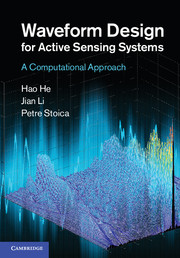Book contents
- Frontmatter
- Contents
- Preface
- Notation
- Abbreviations
- 1 Introduction
- Part I Aperiodic correlation synthesis
- Part II Periodic correlation synthesis
- Part III Transmit beampattern synthesis
- 13 Narrowband beampattern to covariance matrix
- 14 Covariance matrix to waveform
- 15 Wideband transmit beampattern synthesis
- Part IV Diverse application examples
- References
- Index
15 - Wideband transmit beampattern synthesis
from Part III - Transmit beampattern synthesis
Published online by Cambridge University Press: 05 August 2012
- Frontmatter
- Contents
- Preface
- Notation
- Abbreviations
- 1 Introduction
- Part I Aperiodic correlation synthesis
- Part II Periodic correlation synthesis
- Part III Transmit beampattern synthesis
- 13 Narrowband beampattern to covariance matrix
- 14 Covariance matrix to waveform
- 15 Wideband transmit beampattern synthesis
- Part IV Diverse application examples
- References
- Index
Summary
The narrowband transmit beampattern design problem has been discussed in Chapters 13 and 14; see also [Forsythe & Bliss 2005][Stoica et al. 2007][Fuhrmann & San Antonio 2008][Stoica, Li & Zhu 2008][Guo & Li 2008]. Most of the proposed methods first relate the desired beampattern to the covariance matrix of the transmit signals (see, e.g., Chapter 13), and then aim to design the signals that approximate the covariance matrix determined in the first stage (see, e.g., Chapter 14). In the wideband case, similar approaches have been proposed to design the power spectral density matrix [San Antonio & Fuhrmann 2005], but no signals have been synthesized due to the difficulty of imposing the unit-modulus or PAR constraints.
In this chapter we propose an algorithm named WB-CA (wideband beampattern CA) to design unimodular or low-PAR sequences for transmit beampattern synthesis in wideband active sensing systems. We do not formulate the problem in terms of the transmit spectral density matrix (as was done in [San Antonio & Fuhrmann 2005]), but instead directly link the beampattern to the signals through their Fourier transform. The design criterion is formulated in Section 15.1, which is followed by the algorithm description in Section 15.2. Simulation examples are shown in Section 15.3 and concluding remarks are given in Section 15.4.
Problem formulation
We focus on far-field beampattern synthesis for uniform linear arrays (ULA) as illustrated in Figure 15.1.
- Type
- Chapter
- Information
- Waveform Design for Active Sensing SystemsA Computational Approach, pp. 222 - 244Publisher: Cambridge University PressPrint publication year: 2012

